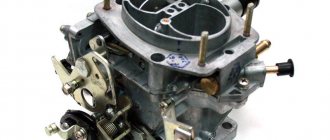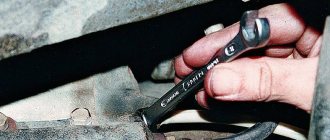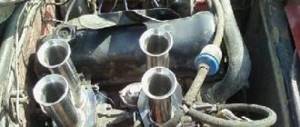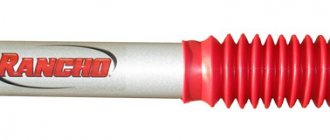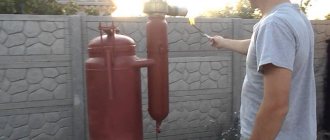Anti-freeze is the popular name for a mixture of glass washer fluid used in cars during winter operation. This term is also often used as a liquid used in the temperature contours of cooling and heating systems, but this article is not about them.
Anti-freeze is not cheap at all when compared with summer washer fluid. The reason for this is obvious - a more complex composition (we will describe it in detail below).
The main task of the anti-freeze, like the summer washer, is to clean the car’s windshield from dirt (some use it to quickly defrost the windshield while warming up). The required characteristics are the absence of the effect of crystallization (freezing) of the liquid at a certain temperature, effective cleaning of the surface from contamination, harmlessness to the human body.
Anti-freeze composition
The typical composition of any winter washer fluid for a car will be as follows:
- Alcohol
- Surfactant
- Water
- Fragrance
- Dye
As you can see, the first three components are key; fragrance and dye are just additives, without which the liquid will work anyway.
There are different types of alcohol used, and this is not an unimportant factor when choosing or making your own antifreeze. The main alcohols used to make winter washer fluid are methanol (35% solution with water), ethanol (40% solution with water), isopropanol (45% solution with water). Since methanol is prohibited in our country, ethanol is widely used. It is used both in the form of a solution (45%) and in “pure” form (94%, ethyl alcohol).
Ethyl alcohol freezes at -114.1 degrees Celsius. Below you will see a table of the relationship between the concentration of ethyl alcohol and its freezing point. Source – Wikipedia.
| Mass fraction of ethyl alcohol content, % | Freezing point, degrees Celsius |
| 11 | -5 |
| 19,1 | -10 |
| 24,2 | -14 |
| 31,2 | -20 |
| 44,8 | -30 |
| 48,2 | -35 |
| 54,75 | -40 |
| 61,5 | -45 |
| 70,3 | -50 |
That is, in order for the winter windshield washer fluid not to freeze at a temperature of -30, it is necessary to make an aqueous solution whose alcohol content will be more than 44.8%, in other words, 450 grams of alcohol per 550 grams of water is already suitable for us. Please note that the units are grams, not milliliters.
There is an alternative to ethyl alcohol - isopropyl alcohol, but it is much more expensive and its frost-resistant characteristics are worse.
| Mass fraction of isopropyl alcohol content, % | Freezing point, degrees Celsius |
| 10 | -5 |
| 20 | -10 |
| 25 | -14 |
| 42 | -20 |
| 61 | -30 |
| 70 | -35 |
| 79 | -40 |
| 76 | -45 |
| 81 | -50 |
This data is already enough for us to make our own winter washer. However, we will offer you recipes not only based on alcohol, but also other substances. The fact is that alcohol formulations have a huge disadvantage - a persistent smell of alcohol, which actively penetrates into the cabin. It is clear that this does not do much good, but moreover, the driver may feel ill while driving, therefore, in part, such washers are even dangerous. Isopropyl alcohol does not have this disadvantage.
Next, we will offer you several recipes, but not all of them will be alcohol-based. We will also describe the pros and cons of these. In addition, at the end of each recipe, an economic calculation of the cost of such a product will be made, and at the end of the article we will be able to summarize the profitability of our venture. The calculation will be made based on the following data (approximate):
| Name | Quantity | Cost, rubles |
| Isopropyl alcohol | 10 grams | 0,31 |
| Ethanol | 10 grams | 0,23 |
| Water | 10 grams | 0,03 |
| Surfactant (car shampoo) | 10 grams | 2 |
Composition of automobile washer fluid
The composition of antifreeze for cars and the proportions of components used are different. They depend on the manufacturer and the temperature conditions for which the liquid is intended. The product is characterized by the following components included in the composition:
- surfactants;
- distiller;
- alcohol-containing products;
- flavoring components.
It is most rational to use monohydric alcohols for this liquid - liquids using isopropanol. This allows domestic manufacturers to reduce the cost of finished products as much as possible. However, this component, along with its low cost, has one significant drawback - an unpleasant odor. Therefore, the composition includes flavoring substances that neutralize this property. But many car enthusiasts believe that the problem is not completely solved.
Higher quality emulsions require the use of ethyl alcohol, which is used in the food industry. This allows you to get rid of the above-mentioned shortcomings, but leads to a serious increase in the price of the liquid, since serious excise taxes are established on such products. In this regard, most manufacturers refused to use such raw materials.
Another possible option is the use of methyl alcohols. This component has the necessary properties:
- free from unpleasant odor;
- capable of not freezing at temperatures up to ninety-eight degrees;
- relatively inexpensive.
But according to domestic legislation, the use of this substance for these products is not permitted due to the presence of fumes that are harmful to health, although in Europe mixtures based on this component are successfully used.
Taking into account the above circumstances, motorists are faced with the question of choosing from among the following means:
- isopropyl emulsions, costing from four hundred to seven hundred rubles in specialized retail outlets. The manufacturer guarantees that the composition will not cause destruction of seals and other elements of the system, but you will have to endure an artificial floral or citrus aroma;
- methanol emulsions at prices ranging from fifty to two hundred rubles, purchased from random distributors, without any guarantee of quality.
Given the small number of alternatives, many car owners make their own mixtures. But not everyone knows what components need to be used and how to mix them correctly. A few recommendations on this matter.
Do-it-yourself antifreeze based on ethyl alcohol
We will offer a recipe for 1 kg of washer that can withstand temperatures down to -30 degrees. If you need a different temperature range, choose the concentration based on the table presented at the beginning of the article, and in the section “Composition of the anti-freeze agent”.
For one liter of ethyl alcohol antifreeze you will need:
- Ethyl alcohol 94% – 450 grams
- Water – 550 grams
- Surfactant – 20 grams
- Fragrance and dye - optional
The preparation process is extremely simple - just mix it all in one container. As a surfactant, you can use any detergent that you have on hand. However, if you want to make a high-quality product (like those sold at a gas station for 500 rubles per 5 liters), it is better to use car shampoo and clean distilled water.
We have already discussed why it is best to use distilled water in the article about summer washing. In short, tap water contains a bunch of impurities that will settle on the surfaces of the washing mechanism and eventually clog it and put it out of action, the same applies to “Fairy” - it dries out the rubber and leaves a residue. As a shampoo, you can use any suitable auto chemicals from the most available ones. Proportions are not very important here, we give you freedom for creativity. We added 20 grams of shampoo to 1 kg of this wash.
It’s important that we give all proportions in grams, which is a unit of measurement for mass. The volume (displacement) of the resulting product in numerical value will be greater than the mass!
You can use any essential oil or even perfume as a fragrance. Any food dyes, potassium permanganate, blue, toilet tablets are also suitable as a dye - it doesn’t matter, the main thing is not to overdo it.
Total: 45*0.23+55*0.03+2*2= 16 rubles.
How to make an antifreeze with your own hands
So, about the methods, compositions and proportions.
It should be recognized that all these “handmade” options are more likely to be suitable only in critical situations (as an exception) - when you can’t buy anti-freeze, but you need to go.
Method 1: Alcohol-based window cleaner
The easiest way to make an “anti-freeze” yourself is to use an alcohol-based glass cleaner as a base.
The advantage is that it already contains the necessary additives that provide good cleaning properties. This product is diluted with water in a ratio of 2 to 1 (that is, 2 parts water to 1 part liquid).
Among the disadvantages, it is worth noting the rather high cost of such a home solution, as well as the fact that the liquid made in this way will not last in severe frost (below minus 10 degrees).
Method 2: from vinegar
A simple “anti-freeze” can be made by mixing water and 9% acetic acid in a one-to-one ratio.
The method is quite cheap, but is only suitable for use in the temperature range from minus 10 to minus 20 degrees Celsius.
If it is warmer outside than minus 10, such a liquid will give a very unpleasant odor in the cabin, if it is lower than minus 20, it will freeze.
Method 3: from ammonia
Do you have aqueous ammonia on hand? It can be mixed with water in a ratio of 2 to 1 (2 parts water to 1 part ammonia) and get an “anti-freeze” for use in mild frosts.
To make such a liquid more frost-resistant, you can add a tenth of vinegar essence (that is, for example, 100 ml of vinegar per 1 liter of finished liquid).
Helpful advice: in any of the options for “homemade” washer fluid, it is better not to use ordinary water, since the salts contained in it lead to clogging of the washer nozzles and their failure. Using distilled water solves this problem.
Method 4: from vodka or alcohol
And, finally, a method that will guarantee a high-quality “anti-freeze” that is safe for the driver’s health and with the required frost resistance.
You'll have to tinker a little more.
The base for the liquid will be ethyl alcohol (or vodka). It is sold in five-liter canisters and at the time of writing this article costs from 900 rubles for 5 liters.
If you take 2 liters of such alcohol and 3 liters of water, you will get a liquid that can withstand frost of at least minus 15 degrees Celsius.
That is, from a five-liter canister of alcohol you will get more than 12 liters of “anti-freeze”, designed for “average” frosts, or much more if the weather conditions are not so severe.
Proportions
Here are the proportions for obtaining the required frost resistance for a homemade “anti-freeze” made from alcohol (vodka).
| Temperature, degrees C. | Water content, % |
| —1 | 97 |
| —5 | 88 |
| —10 | 79 |
| —16 | 72 |
| —23 | 64 |
| —29 | 57 |
| —33 | 49 |
| —41 | 37 |
| —51 | 16 |
Helpful tip : for all methods except number one, it makes sense to add about a tablespoon of dishwashing detergent per 1 liter of prepared liquid to increase its cleaning ability.
You can tint such a finished liquid by adding regular blue.
It needs to be added gradually, stirring the solution until you get a liquid of the color you want. From the point of view of cleaning abilities and other things, this is not important, the moment is purely aesthetic.
Antifreeze based on isopropyl alcohol
To independently prepare 1 kg of winter wash that will withstand frosts of -30 degrees Celsius, from isopropyl alcohol you will need:
- Isopropyl alcohol – 680 grams
- Water – 320 grams
- Surfactant – 20 grams
- Fragrance and dye - optional
The manufacturing process is similar, but, as you can see, we need 51.1% more of the most expensive product! Everything else is the same as in the case of the first recipe.
Total: 68*0.31+32*0.03+2*2=26.04 rubles.
Anti-freeze based on window cleaner
These products are well suited to be used for inclusion in this composition. The procedure does not take much time and does not require much work. When choosing a detergent in a store, the main thing is to study its composition in detail (only alcohol-containing liquid is suitable) and maintain the appropriate ratio of components.
The emulsion is mixed in the following proportions: one third of alcohol-containing detergent - two thirds of distiller. If you assume the presence of distilled water in a volume of five liters, the specified detergent will need two and a half liters, the final yield is seven and a half liters of liquid.
DIY winter wash made with vinegar
Please note that I used the word “washer” and not “anti-freeze”. The fact is that vinegar with a concentration of 6, 9 and 12% is freely available, and it freezes at temperatures of -2, -3 and -4 degrees Celsius, respectively. Obviously, if we mix it with water, we will not get a quality product. Yes, perhaps at -5 it will still “live”, but you shouldn’t count on serious temperatures.
Even to maintain a liquid state at a temperature of -5 degrees Celsius, a 1:1 solution is required, that is, 500 grams of 12% vinegar per 500 grams of water. If you get 70% or 90% vinegar, even with this concentration, the maximum you can count on is -10 degrees Celsius. Of course, you can add more vinegar, but then both you and the car will smell of this sour aroma. The rubber bands and paintwork of a car will also not last long under such use.
Total: 35 (this is how much the cheapest 12% vinegar in a 500 ml container costs) + 1.5 + 4 = 55.5 rubles.
Methanol, ethanol, isopropyl: which antifreeze to buy this winter
Photo: cars.com
Legal anti-freeze is more expensive, but it smells bad and cleans glass worse. Even the materials of Rospotrebnadzor say that isopropyl alcohol has an unpleasant, pungent odor, reminiscent of acetone, but is not toxic to humans. In order to eliminate the unpleasant odor, special fragrances are added to the antifreeze, which do not completely eliminate the odor, but increase the price of the product. In addition, isopropyl alcohol freezes at a higher temperature, so its concentration in the commercial liquid must be higher.
Why is methanol legal abroad?
According to Rospotrebnadzor, more than a thousand cases of methanol poisoning are registered in Russia every year, and all of them are associated with the deliberate ingestion of methanol-containing substances. Most often, these incidents occur at illegal washing plants, where raw materials are supplied unlabeled under the guise of industrial alcohol. However, there is no information about the presence of casualties as a result of the normal use of car washer.
Articles November 16, 2020 “People don’t know what they’re dealing with.” Why is antifreeze dangerous?
Articles November 25, 2013 What kind of “anti-freeze” makes people go blind and die?
In most countries, including European and American ones, methanol antifreezes are produced - it is believed that no one there will drink them instead of food alcohol. However, the cost of liquids there is much higher than in Russia, and the production technology may differ markedly. At the same time, canisters with methanol-based liquid must be marked with warning signs about toxic contents and safety precautions are described.
What to do in case of methanol poisoning
Methyl alcohol affects the nervous system and is especially dangerous for the organs of vision. Small doses irritate the mucous membranes of the respiratory tract and eyes, larger doses lead to dizziness, blurred vision, and diseases of the gastrointestinal tract. Symptoms of poisoning may not appear immediately, but within a period of 6 to 30 hours.
Autonews car services Guarantee of good conditions Wheel alignment 1500 ₽ Replacement of brake pads 700 ₽ Oil change 500 ₽ Bumper painting 3000 ₽
If you suspect methanol poisoning, you should immediately call an ambulance, rinse your eyes and mouth with clean water and try to remove methanol from the body. To do this, you need to force the victim to drink as much water as possible and give him sorbents, such as activated carbon. There is also a popular recommendation to drink vodka, since the ethanol contained in alcohol is a competitive antidote to methanol and promotes the removal of methanol without oxidation. Doctors consider no more than 100 g of vodka per day to be a sufficient dose for a person of average build.
Can methanol be allowed?
In addition to Gennady Onishchenko’s order of 2000, Russia has another order of the Chief Sanitary Doctor of 2007, which directly prohibits the production and circulation of any methanol-based automotive fluids. In addition, the ban on methanol from 2020 is also contained in the Technical Regulations of the Customs Union.
Experts have more than once proposed launching the production of denatured methanol with a taste that makes it impossible to ingest it: specialized companies already have a number of similar developments. However, to produce such washers, an appropriate legislative framework is required, and no one is going to change it yet.
Antifreeze based on ammonia
Ammonia is an excellent alternative to ethanol and isopropyl. Ammonia has a fairly affordable price tag, but it is not without the main disadvantage of cheap ethanol - a terrible smell, and even more - its use is detrimental to paintwork.
For the average citizen, 8, 13, 19 and 25 percent aqueous solutions of ammonia are available for purchase. The freezing gradient is also interesting - 8% crystallizes at -10, 13% at -20, 19% at -30 and 25% at -40 degrees Celsius.
That is, using 500 ml of ammonia 25% and 500 ml of water we will get a washer that will freeze at -20 degrees Celsius. Well, that's the same. At the same time, for 1 liter of ammonia you will pay around 200 rubles.
Total: 100+1.5+4=105.5 rubles.
Is it possible to use winter washer in summer?
You can use a winter washer in the summer, but there is absolutely no point in doing so, just a waste of money. Let us repeat - alcohol, as such, does not cope very effectively with dirt and even insect remains; other additives do this for it. Its main task is to achieve frost resistance for the washer fluid.
And to save money, we have written several recipes for you, according to which you can make a summer wash with your own hands.
conclusions
As you can see, making a winter washer with your own hands is very simple, because it is not demanding on the detergent, and “anti-freeze liquids” are freely available. The concentration and formulation must be selected based on the region of operation. Obviously, in the southern regions and the middle zone, options with a 45% share of ethanol are not needed at all, and a decrease in the mass fraction of alcohol will proportionally reduce the cost of the washer. For the northern regions, the vinegar recipe is not suitable at all, but in Moscow and further south it will work very well (subject to the European winter).
However, let's summarize the financial results. The cheapest winter washer up to -30 degrees Celsius with good reviews on Yandex.Market costs about 120 rubles, but this does not include delivery, so we can safely increase the price tag to 170 rubles. The most expensive ones cost 700 rubles, but again we add delivery – 750 rubles. This is the cost of containers for 5 liters.
Our artisanal products received the following cost per 5 liters:
- Based on ethanol – 80 rubles
- Based on isopropyl – 132 rubles
- Vinegar based – 277 rubles
- Based on ammonia - 527.5 rubles
Having set a filter by composition on Yandex.Market, we can safely assume that anti-freeze products up to 300 rubles are based on ethanol, and among products costing more than 300 rubles you can already find products containing isopropyl alcohol. Based on this, the following conclusions can be drawn:
- Yes, making a winter anti-freeze washer with your own hands is profitable, even when compared with the very bottom of the market
- You can use high-quality components (the same isopropyl alcohol) and still win 100% or more of the cost on the market
- Homemade washers without alcohol are expensive and impractical.
It is worth considering some other points regarding the independent production of winter windshield washer fluid for a car - you spend your personal time on its production (anything at all), purchasing ingredients, and at the most you will need to stand in a short line at the store; a product made with our own hands according to our recipe is hypoallergenic and safe for people with relevant health problems.
If you liked and even found this article useful, please add it to your bookmarks and be sure to share it with your friends on social networks, and also rate it with the number of stars it deserves. Any interesting recipes? Share them in the comments!
Vinegar and ammonia
If your budget is extremely limited, you can avoid using alcohol in the composition altogether. Vinegars and ammonia have similar properties. They practically do not freeze, but they have an unpleasant odor that does not disappear for a long time. Volatile substances evaporate quickly at temperatures below minus 50 degrees, so such liquids are good for the Far North.
To prepare the first option, you will need vinegar at a concentration of 9% and distilled water. You need to mix them in a 1:1 ratio. It is important to remember that you need to pour acid into water, and not vice versa. To make your own anti-freeze for cars based on ammonia without alcohol, mix water and the active substance in a 3:1 ratio. The liquid will not lose its properties even at -200 degrees.
Do-it-yourself winter washing does not allow you to save significantly, since ready-made compounds are already sold much cheaper. However, if the proportions are strictly observed, you can obtain a mixture that will withstand the design temperature. It would be optimal to make anti-freeze at home for cars using isopropyl, but you can also use more expensive ethylene. Homemade anti-freeze for cars based on vinegar and ammonia also performs well, but it has an unpleasant odor.
What to do if the washer fluid is frozen in the tank
There are several ways to defrost washer fluid in the washer reservoir:
- Warm up the car in a warm room
- Defrost the tank with boiling water
- Defrost the tank with alcohol
- Melt ice by warming up the car
The easiest way is to drive the car into a warm garage or box and let it sit there for 1-2 hours. In addition, to speed up the process of defrosting the washer fluid, you can use a hair dryer or any other device to create a stream of warm air. The main thing is not to overdo it with the temperature.
You can defrost the tank with boiling water - just pour it inside; in addition, you can carefully pour boiling water over the body of the tank, but in this case there is a possibility that the tank will burst.
Pure alcohol works great with ice (you can even use vodka), but this process is not quick. We also pour liquid inside the tank.
The most commonplace way is to warm up the engine compartment of the car, that is, we simply start the car and wait until the tank comes away on its own. To speed up the process, you can place a cardboard in front of the radiator so that when the engine reaches a high temperature, it will give off less heat to the outside, and the cardboard will also allow the warm air to dissipate throughout the engine compartment.
